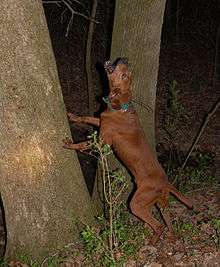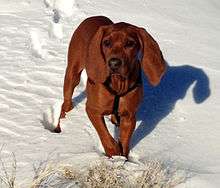Redbone Coonhound
 A female Redbone Coonhound | |||||||||||||||||||||
| Common nicknames | Reds | ||||||||||||||||||||
|---|---|---|---|---|---|---|---|---|---|---|---|---|---|---|---|---|---|---|---|---|---|
| Origin | Southern United States | ||||||||||||||||||||
| |||||||||||||||||||||
| |||||||||||||||||||||
| Domestic dog (Canis lupus familiaris) | |||||||||||||||||||||
The Redbone Coonhound is an American breed of dog used for hunting raccoon, deer, bear, and cougar. The American Kennel Club standard says, "The Redbone mingles handsome looks and an even temperament with a confident air and fine hunting talents."[1] This breed has been registered with the United Kennel Club since 1902 and the American Kennel Club since 2009. The Redbone is the breed of hound featured in the classic novel Where the Red Fern Grows.
Description

Appearance
The Redbone Coonhound has a lean, muscular, well proportioned build. The body type is typical to the coonhounds subgroup, with long straight legs, a deep chest, and a head and tail that are held high and proud when hunting or showing. The Redbone's face is often described as having a pleading expression. The dog's eyes may be dark brown to hazel, but a darker color is preferred.[2] The coat is short and smooth against the body, but coarse enough to provide protection to the skin while hunting through dense underbrush. The large paws have especially thick pads, with webbed toes, and dewclaws are common. The nose should be black and prominent. The ears are floppy and should extend to nearly the end of the nose if stretched out. Coloration of the nose is black, and the coat color is always a rich red, though a small amount of white on the chest, between the legs, or on the feet is permissible, though not preferred.[2] Variations of black fur on the face and muzzle are also not uncommon.
Males should be 22-27 inches (56-68.5 cm) at the shoulder, with females slightly shorter at 21-26 inches (53–66 cm). Weight should be proportional to the size and bone structure of the individual dogs, with a preference towards leaner working dogs rather than heavier dogs. Generally, weights will range from 45 to 70 lbs (20.5 to 31.75 kg).[2]
Temperament
The Redbone Coonhound is affectionate, gentle, and should have a strong desire to please its owner.[2]
The Redbone is an extremely vocal dog, as would be expected of a hound. The breed is known for its distinctive "drawling" bark, also known as a bay. Hunters who use the breed follow the sound of the voice as the dogs track quarry. It takes training to first control their excited, emotional, booming barks, but also to help provide the hounds an outlet for their 'tracking' desires that sometimes drive their vocalizations. A Redbone Coonhound will have a "specific" bay when it has an animal either treed or cornered. This bay is very much distinguishable from their normal day to day baying.

Redbones do not reach full physical and mental maturity until the age of two years, comparatively slower than many other breeds. As with all breeds, puppies and adolescents are more energetic than adults and need lots of activity or they will become destructive, often chewing furniture, chewing shoes, and snooping around the garbage. When going through obedience training it is imperative for a pet owner to know that harsher methods are not effective with this breed. Coonhounds are typically stubborn but can also be sensitive; being overbearing can frighten the animal. Once trained and aware of its size the breed is known to be very gentle and can be trusted with children. While playing with older children they will happily jump into the family swimming pool to play. The dogs are adept in the water and can be compared to other water-loving breeds like the Labrador Retriever in swimming ability.
Coonhounds are in the same group as well known breeds such as the Beagle, Basset Hound, and Bloodhound: they are bred primarily to track game using sight and scent over long distances. They also instinctively mark their position for following hunters by vocalizing as they catch up with their quarry. Therefore, this breed will have the desire to chase small animals such as rabbits, squirrels, badgers, or even cats. A Redbone Coonhound should have a tall fence to retain the animal and keep it from wandering.
Hunting dogs require a good deal of exercise to stay happy and healthy. The breed is best suited to the countryside or suburbs; urban environments are less than ideal but workable so long as they get roughly an hour and a half or more of walking per day. Redbones are known to have an independent intelligence especially well suited for problem solving. This can be an issue if the problem they want to solve is their backyard fence or the dog-proof garbage. Most Redbones require leashes to avoid wandering. In a hunt setting they will often make quarter mile loops away from the pack searching for scent of their prey before returning or using their bay to raise the alarm, thus bringing the pack to their aid. Because of their instinctive desire to follow scents, they are eager to follow their noses and may ignore their owners' commands.
History
In the late 18th century, many European-type hunting dogs were imported to America, most of them of Scottish, French, English, and Irish ancestry: the English Foxhound, the Harrier, the Grand Bleu de Gascogne, the Welsh Hound, the Beagle, and the Bloodhound were among these. Most often, these dogs were imported so that wealthy planters of the Tidewater could engage in foxhunting. Over time, Southern hunters selectively bred dogs that would not back down, had great stamina, and would "hound" their prey until they treed or cornered their exhausted quarry, leading to modern coonhounds.
.jpg)
In the late 18th century Scottish immigrants brought red-colored foxhounds to Georgia, which would be the foundation stock of the Redbone. Later, approximately 1840, Irish-bred Foxhound and Bloodhound lines were added. The name came from an early breeder, Peter Redbone of Tennessee, though other breeders of note are Redbone's contemporary, George F.L. Birdsong of Georgia, and Dr. Thomas Henry in the 19th century.[3] Over time, breeders followed a selective program that led to a coonhound that is specialized for prey which climbs trees, was unafraid of taking on large animals, was agile enough to carry on over mountain or in meadow, and liked to swim if necessary. They were ideal for pack hunting of both small and larger prey. Originally, the Redbone had a black saddleback, but by the beginning of the 20th century, it was an uninterrupted red tone.[3][4]
Like many American hunting dogs, especially those from the South, they were widely known by hunters and farmers, but not well known in the show ring. The Redbone has found recognition by the two major American kennel clubs. Because of of its main use as a hunting dog rather than a show dog Redbones are extremely rare dogs outside of the United States. There are very few breeders outside of North America and it is virtually unknown in Europe or Australia.
The Redbone Coonhound was recognized by the United Kennel Club in 1902, becoming the second coonhound breed to gain recognition.[2]
The Redbone Coonhound was popularized after the novel Where the Red Fern Grows, written by Wilson Rawls, was published in 1961. It told the story of Billy Colman and his Redbones.[4]
The Redbone Coonhound was recognized by the American Kennel Club in 2010.[3] It was shown at the Westminster Kennel Club Dog Show for the first time in 2011.
Famous Redbone Coonhounds
- Where the Red Fern Grows is a story about two Redbone Coonhounds ("Old Dan" and "Little Ann") and their owner Billy Colman. The book was written by Wilson Rawls in 1961, then turned into a movie in 1974.
- The Hound That Thought He Was a Raccoon is a story about a young Coonhound puppy raised by a family of raccoons. The film was made by Walt Disney Productions in 1960.
- The Outlaw Josey Wales is a story of a Civil War Veteran who has everything, including his family, taken from him by a group of renegade Union Soldiers. During his quest for vengeance, he picks up other loners who accompany him on his path, one of which is a Redbone Coonhound.
References
- ↑ Redbone Coonhound, American Kennel Club, retrieved 11 August 2014
- 1 2 3 4 5 "United Kennel Club Standard for the Redbone Coonhound". United Kennel Club. Retrieved 20 August 2016.
- 1 2 3 Club, The American Kennel (11 November 2014). "The New Complete Dog Book: Official Breed Standards and All-New Profiles for 200 Breeds- Now in Full-Color". i5 Publishing – via Google Books.
- 1 2 Club, American Kennel (18 December 2007). "The Complete Dog Book: 20th Edition". Random House Publishing Group – via Google Books.
External links
| Wikimedia Commons has media related to Redbone Coonhound. |